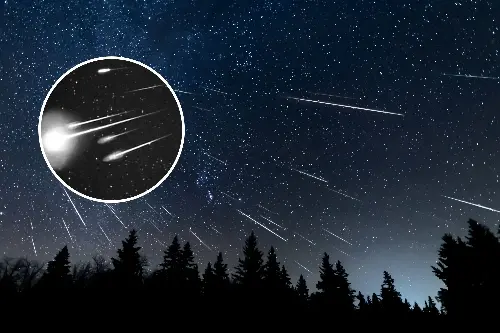
The annual Leonids meteor shower is due to peak next week, hopefully giving stargazers a treat to brighten up the dark winter evenings.
The Leonids are due to show between November 3 and December 2 this year, and predicted to peak on the night of November 16, according to the American Meteor Society.
Up to 15 meteors per hour could be visible, with shooting stars rocketing toward the Earth at 44 miles per second. Their high speed often results in bright and colorful meteors, with fireballs also being common during this shower.
How to watch the Leonids meteor shower
This annual meteor shower is named for the constellation Leo, which is where its meteors appear to come from in the sky—known as the shower's radiant. The radiant is due to rise in the eastern skies about midnight on the night of the peak, meaning that optimum viewing will be between then and dawn. However, the meteors will be visible from anywhere in the sky.
For the best experience, try to find a location with minimal light pollution, lie back to take in as much of the sky as possible, and let your eyes adjust to the darkness. Patience is key, as meteor activity may vary throughout the night.
"The Leonids are best viewed starting at about midnight local time. Find an area well away from the city or streetlights. Come prepared for winter temperatures with a sleeping bag, blanket, or lawn chair. Orient yourself with your feet toward the east, lie flat on your back, and look up, taking in as much of the sky as possible," NASA advises.
Every few decades, Leonids can produce a meteor "storm," with rates of up to thousands of meteors per hour. In 1966, up to a thousand meteors per minute were recorded at certain points, and in 1833, an estimated 100,000 meteors per hour were seen.
Samantha Rolfe, a technical tutor at the University of Hertfordshire, told Newsweek: "Occasionally the Leonids have been reported to have spectacular showers or a 'meteor storm' where there can be thousands of meteors per minute for a short period, this is typically in the years following the most recent pass of the comet through the inner solar system refreshing the debris cloud."
The last Leonid meteor storm occurred in 2002, and the next may not be until 2032-2034, after the comet that causes the shower returns in 2031.
Unfortunately for hopeful stargazers, this year the moon will be 98 percent full on the night of November 16, due to the full moon falling on November 15.
"You need dark skies, and the presence of for example a full moon can stop you seeing the fainter meteors. So even a good potential shower can be ruined if we have a bright Moon over many days," Daniel Brown, an associate professor in astronomy and science communication at Nottingham Trent University, previously told Newsweek.
What causes the Leonids meteor shower?
The Leonids meteor shower is caused by debris left behind by Comet 55P/Tempel-Tuttle. This comet, which orbits the Sun every 33 years, sheds particles and dust as it approaches the inner solar system. When Earth crosses this trail of comet debris each November, the tiny particles enter our atmosphere and create bright streaks in the sky—meteors—as they burn up.
"When the comet orbits, it leaves a trail behind it due to the gravitational pull and interactions with mostly the sun, which melts and removes material which is then seen as a comet tail by observers on earth, leaving behind this debris," Christopher Conselice, a professor of astrophysics at the University of Manchester in the U.K. previously told Newsweek. "These showers occur when the Earth's orbit intersects these pockets of debris which are within the solar system in long streams of matter left over."
Every 33 years, when Comet Tempel-Tuttle returns close to the Sun, it leaves a fresh, dense trail of debris, which can lead to the intense meteor storms when Earth passes through the thickest parts of this trail.
Do you have a tip on a science story that Newsweek should be covering? Do you have a question about meteor showers? Let us know via [email protected].
Related Articles
- How To See the Taurid Meteor Shower Peak in the Night Sky
- When Is the Next Meteor Shower After the Orionids?
- Orionid Meteor Shower Peak Next Week May Be Spoiled
- Orionids Meteor Shower 2024: How To See Light Show Peak This Week